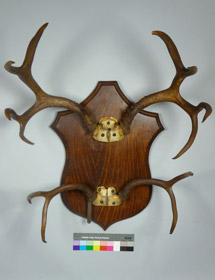Ivory, bone and antlers are often used in the fabrication of art objects or are prized purely for their form and scarcity. These materials are organic in nature, their main component being either calcium phosphate or hydroxyapatite. Ivory, bone and antlers are often carved and at times dye and ink is used to further decorate the surfaces. These materials are very susceptible to extreme fluctuations in temperature and humidity and are extremely hygroscopic, meaning they are very reactive to moisture. Many cultures around the world have a long tradition of using ivory, bone and antler. Some examples are scrimshaw and netsuke.

caption placed here
second line here
This incredibly real looking banana, made in Japan in the 19th century (Meiji Period), is carved from elephant ivory and further decorated with ink. Elephant and mammoth ivory can be identified by their characteristic Shrager lines. The object fell and the “peel” broke off and small parts of the tip of the peel were broken and lost. The surface also had a medium to heavy build up of surface dirt and grime. The ivory was first cleaned using the appropriate wet and solvent methods. The area of loss was filled and inpainted and the peel was adhered back in to place. It is interesting to note that an actual banana was used as a tool from which to sculpt the lost tip.

Carved Ivory Banana Before Treatment

Carved Ivory Banana After Treatment



